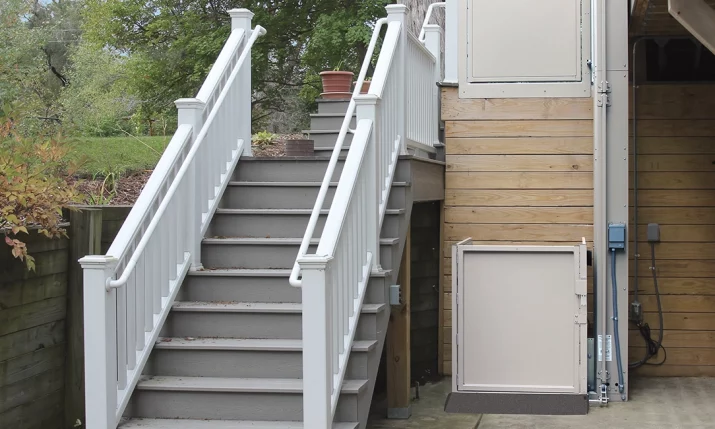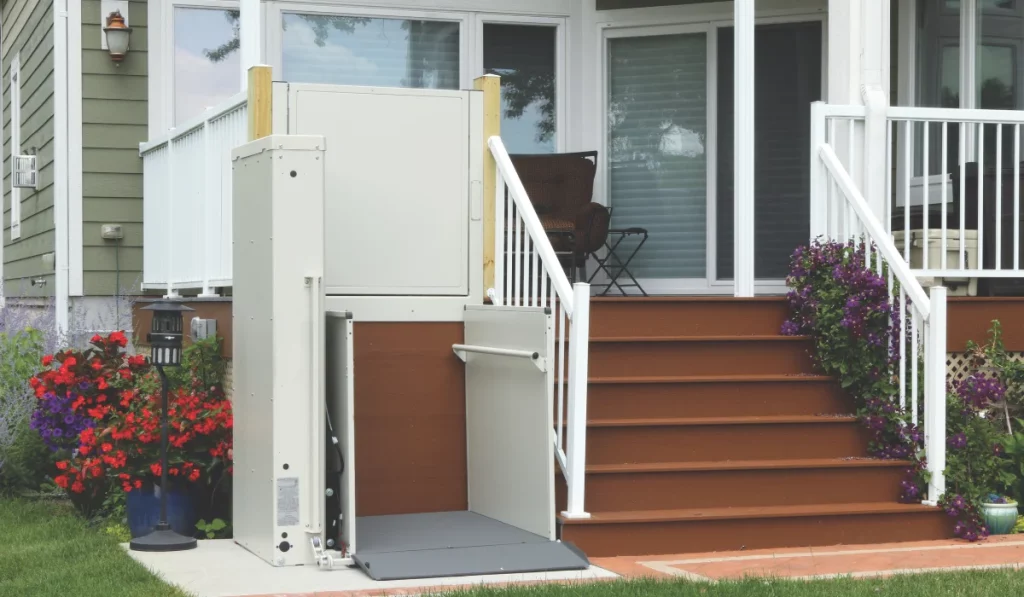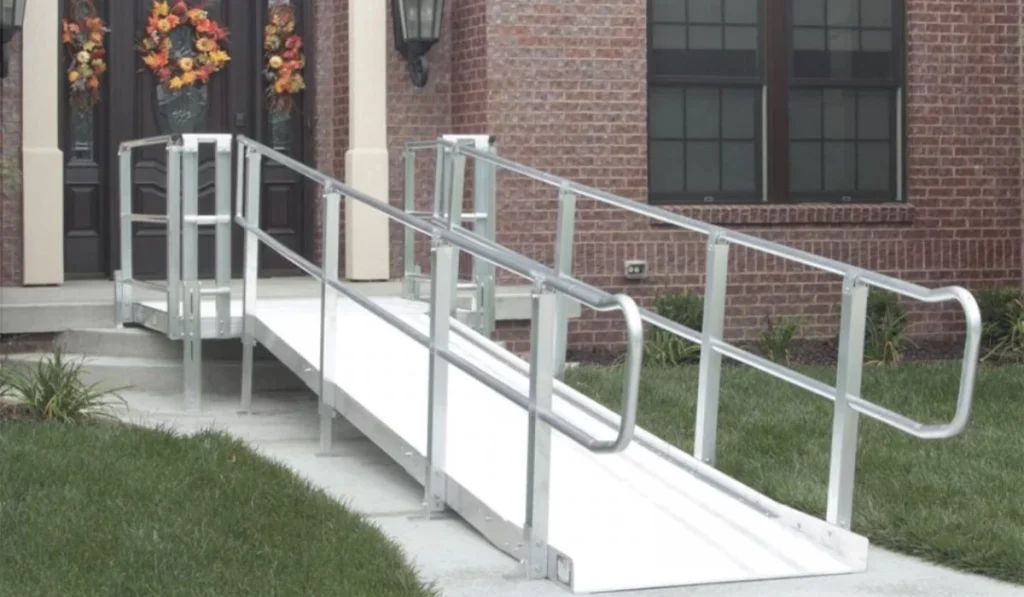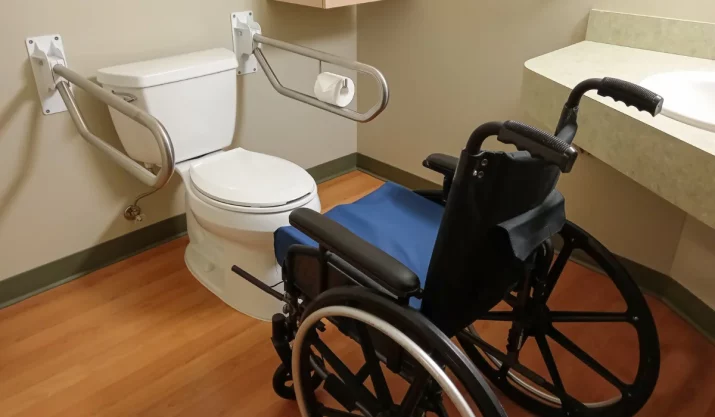How to Choose Between a Vertical Platform Lift and a Ramp

Table of Contents
If you’re deciding between a vertical platform lift (VPL) and a ramp, you’re likely thinking about long-term safety and mobility. Both are excellent accessibility solutions, but the right choice depends on your space, budget, and specific mobility needs, whether you use a wheelchair, scooter, or power chair.
Accessibility isn’t one-size-fits-all. What works for one home or one person may not be ideal for another. Factors like yard space, climate, and even local building codes can play a big role in what’s possible or practical. And beyond the specs, there’s the day-to-day ease of use to think about. The right solution should not only meet code but fit seamlessly into your lifestyle.
This guide walks you through the differences so you can make the choice that fits your life, not just your layout.
Key Takeaways
- Ramps are best for small elevation changes (under 18 inches) and require significant space due to ADA slope requirements (1:12 ratio), but they’re budget-friendly and low-maintenance.
- Vertical Platform Lifts (VPLs) are ideal for higher elevations (over 2–3 feet) or where space is limited. They offer compact, reliable access in areas where ramps aren’t practical.
- VPLs include safety features like constant-pressure switches, backup batteries, and weather-resistant controls, making them suitable for all-weather, daily use.
- Choosing between a ramp and a VPL depends on your space, budget, and mobility needs, and in some cases, a combination of both might be the best solution.
What is a vertical platform lift?

A vertical platform lift, or VPL, is a powered lift that raises and lowers people in wheelchairs or scooters vertically between levels. Think of it as a small elevator designed for wheelchairs. It’s often installed next to a porch, deck, or short set of stairs and can be used in both residential and commercial settings.
VPLs come in different models, like enclosed vertical platform lifts for weather protection or unenclosed versions for quicker access. Brands like Bruno and Harmar are commonly used in both residential wheelchair lifts and commercial buildings.
What is a ramp?

A ramp is a sloped surface that provides access between different elevations. It’s simple, low-tech, and often more affordable upfront. Ramps are frequently used outside homes, public buildings, or anywhere a mobility device needs to transition over a height difference without steps.
ADA guidelines recommend a 1:12 slope ratio, meaning for every inch of vertical rise, you need 12 inches of ramp. That adds up quickly. For a 30-inch rise, you’re looking at a 30-foot ramp.
| Feature | Ramp | Vertical Platform Lift |
|---|---|---|
| Cost | Lower upfront | Higher upfront |
| Space Required | High | Low |
| Maintenance | Minimal | Moderate |
| Max Height | Up to ~18″ practical | Up to 6–12 ft |
| Weather Suitability | Needs upkeep | Weatherproof models available |
When a ramp makes sense
You have space
Ramps need a lot of room. If your elevation change is minor (under 18 inches), a ramp might be all you need. But anything higher becomes difficult to accommodate. Ramps for taller rises can dominate your front yard or driveway.
Your budget is tight
Ramps generally cost less than VPLs to install. They’re often a more cost-effective option for small height changes, especially if you don’t need specialized materials or weather protection.
You want minimal maintenance
A well-built ramp doesn’t have moving parts. That means fewer safety features to monitor and no drive system to service. A quick sweep and occasional de-icing are usually all it takes to keep a ramp safe for outdoor use.
When a vertical platform lift is better
Your elevation change is significant
If you need to clear more than 2–3 feet of vertical height, a VPL is often a better choice. Unlike ramps, lifting height doesn’t dramatically increase the footprint of a VPL. For tall porches or multi-level entries, it can make access practical where a ramp can’t.
Space is limited
Not every home or property has room for a 30-foot ramp. VPLs are compact. Most require only a few feet of clearance on the ground and around the top landing. If you live in a dense neighborhood or have limited outdoor space due to landscaping, a lift might be the only viable solution.
You need it to work in all weather
Modern VPLs come with non-skid platforms, interlocks, landing gates, and emergency stop buttons to meet ADA standards and ensure safe travel, even when it’s raining or icy. Brands like Highlander by Harmar or a Bruno vertical platform lift are built for outdoor use with sealed controls and protective finishes.
Safety and ease of use
VPLs use constant-pressure switches for operation, which means the lift only moves when you press and hold the control. That ensures the user is engaged and in control the entire time. Lifts also have built-in sensors, battery-powered backup systems for power outages, and various safety features that make them secure and dependable.
Ramps are passive. They don’t fail mechanically, but that also means users are responsible for all movement. Wet leaves, icy conditions, or steep slopes can make a ramp dangerous without proper upkeep.
Installation and long-term care
Installing a ramp often involves simple carpentry, depending on the height and surface. A VPL, on the other hand, requires electrical work and potentially a shaftway or hoistway if enclosed. Some use acme screw or hydraulic drive systems, depending on the model.
If you choose a VPL, check the warranty. Units from reputable manufacturers often include multi-year coverage and options for commercial use. And keep in mind that maintenance needs vary, some VPLs are easier to service thanks to screw drive mechanisms.
Comparing platform sizes and weight limits
When looking at platform lifts, platform sizes and weight capacity are critical. Most VPLs can accommodate at least 600 pounds, enough for most scooter users or wheelchair users with an assistant. Always check the lifting capacity against your needs.
Ramps, by contrast, can support similar loads, but wear and environmental exposure can reduce stability over time, especially for wood ramps.
Final thoughts: What’s right for your home?
If your home has a steep entry or limited yard space, a vertical platform lift likely makes the most sense. They’re safe, space-efficient, and versatile, especially for people using wheelchairs or scooters regularly.
If you’re only overcoming a small height or you want something simple and budget-friendly, a ramp is a solid option. Just make sure you have the room and proper materials for a safe slope.
Want personalized guidance? Sometimes, the right answer isn’t one or the other, it’s both. If you’re in California and want help figuring out the best lift solution for your property and mobility needs, we’re here to help. Reach out and we’ll walk you through it, no pressure.






